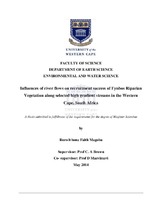| dc.description.abstract | Riparian vegetation occurs in two distinct zones, the wet bank and the dry bank. Knowledge on how the flow regime influences the zonal structure of riparian vegetation is required to mitigate the adverse effects of water resource utilization on riparian vegetation. The first objective of this study was to determine whether flow exerts a physical influence on zonal structure pre- or post-recruitment. An examination of the survival of seedlings and saplings was conducted along Western Cape rivers to investigate seedling persistence and survival on lateral zones. A comparison of the ratios of seedlings, saplings and adults in different riparian zones for the years, 2004, 2011 and 2013, was carried out. The results suggest that in general seeds are deposited randomly on the banks, where they germinate and become seedlings. Seedlings that become established at locations unsuitable for their persistence into adulthood are removed either by high flows or perish during dry conditions. Thus, lateral zonation eventually develops due to species differences in tolerance to conditions at different positions on the banks. The second objective was to explore the effects of the reduction in dry season low flows on the recruitment success of riparian species at sites upstream and downstream of abstraction points. At most sites plants were arranged into different lateral zones and the numbers of species between upstream and downstream sites were not significantly different. There were significant differences in the abundances between up- and downstream sites, with the loss of herbaceous plants and sedges at downstream sites, both of which favour moist conditions. Also, in the absence of dry season flows, the seedlings of dry bank tree species recruited closer to the channel than those at the sites with summer flows. The shifting of the dry bank into the channel narrows the channel, which may affect the hydraulic pressures exerted during floods. The spatial arrangement in the riparian zone has as much to do with flow conditions post recruitment as it does with conditions during recruitment. This shows that the structure of riparian plants is determined not only by whether or not the minimum flows are met, this points to the need to reinstate the naturally variable flow and adopting a holistic approach for the understanding and management of aquatic systems. | en_US |

